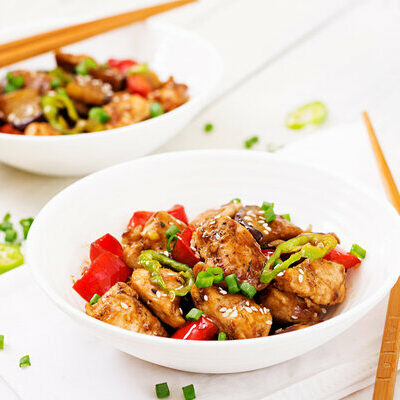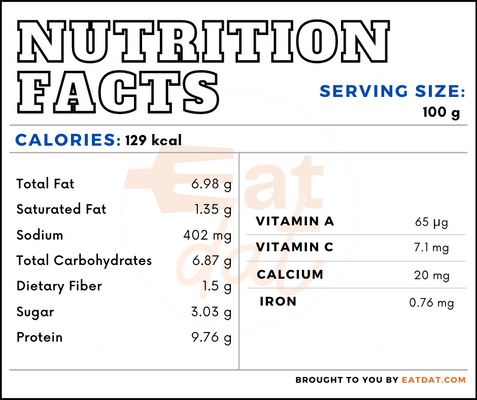
Kung Pao Chicken
What is Kung Pao Chicken?
Kung Pao Chicken is a Chinese dish prepared with chicken, peanuts, vegetables, and chilies. It is an integral part of Sichuan cuisine and was originally prepared with Sichuan peppercorns. Other ingredients used may include soy sauce, ginger, garlic, green onions, cooking wine, vinegar, and sesame oil. The dish has a dark brown color due to the sauce.
- Also, it is comparatively dry and is a stir-fried dish.
- The dish has a signature strong taste that incorporates flavors of sweet, sour, and savory along with the heat from the chilies.
Some popular Chinese dishes throughout the world are:
- Hotpot
- Braised Pork Balls in Gravy
- Shrimp with Vermicelli and Garlic
- Dumplings
- Chow Mein
- Peking Roast Duck
- Steamed Vermicelli Rolls
- Fried Shrimp with Cashew Nuts
- Sweet and Sour Pork
- Kung Pao Chicken
Origin of kung pao chicken
The creation of Kung Pao Chicken is credited to Ding Baozhen, a man from the Guizhou province. As a boy, he had fallen into water and was saved from drowning by a local. Years later, when Ding had become a governor in Sichuan, he returned to visit the man who saved his life. During the visit, he was served a dish which he enjoyed a lot and returned back home with the recipe. He began serving it in his home and soon it spread throughout Sichuan. It was given the name Gongbao Jiding, based on the name of the man who saved Ding’s life.
Nutrition
Nutritional profile for kung pao chicken (100 gms):

Kung Pao Chicken is rich in micronutrients such as potassium, sodium, carotene, and lutein. Also, it has decent amounts of calcium, magnesium, phosphorus, selenium, vitamin C, folate, choline, vitamin A, cryptoxanthin, and vitamin K.
Chicken contains proteins, lipids, B-vitamins such as thiamin, pantothenic acid, and pyridoxine, iron, zinc, copper, and other micronutrients in decent quantities. Chicken, paired with vegetables, can provide a highly balanced diet conducive to good health. Additionally, it is associated with lower risk of obesity, cardiovascular diseases, type 2 diabetes, and cancer. Furthermore, it is considered a healthful food to eat during pregnancy, breastfeeding, and old age. The presence of omega-3 and omega-6 fatty acids in chicken also help in growth and development, increased performance, and improved fertility.
Peanuts contain bioactive compounds such as arginine, resveratrol, phytosterols, phenolic acids, and flavonoids, which may reduce the risk of cardiovascular diseases, colorectal cancer, diabetes, Alzheimer’s disease, and obesity. However, some people may experience peanut allergies, which can be quite severe. Soy sauces are classified as textured vegetable protein and are considered a suitable substitute for meat products, both in taste and in protein intake. Moreover, soy foods have a positive impact on women’s health. They help in keeping the blood pressure in check and have anticarcinogenic properties.
Commercial production
To prepare Kung Pao Chicken, first the peanuts must be roasted in a bit of sesame oil and set to cool. Meanwhile, the chicken must be chopped into pieces and marinated in a sauce made of sesame oil, corn starch, Shaoxing wine, salt, and pepper. Then, the marinated chicken pieces are stir-fried in oil and kept aside. Next, the ginger, garlic, green onions, chilies, and Sichuan peppercorn are then stir-fried and the fried chicken added to it.
After that, a sauce prepared from light soy sauce, dark soy sauce, rice wine vinegar, sugar, and cornstarch is then added to the dish and cooked until it thickens. Finally, the roasted peanuts are added last. The dish is often served with rice.
Kung pao chicken recipes
This chicken is a spicy stir-fried Chinese dish enjoyed around the world. Here are a few recipes:
FDA regulations
The FDA classifies both soy sauce and vinegar as condiments. In addition, soy sauce in its different forms is regulated by the FDA. The USDA regulates all meat products, including chicken, which fall under the general classification of poultry. Chickens are classified into Rock Cornish game hen, Rock Cornish fryer or roaster or hen, Broiler or fryer, Roaster or roasting chicken, Capon, Hen or fowl or baking or stewing chicken, and Cock or rooster.
References
Arya, Shalini S et al. “Peanuts as functional food: a review.” Journal of food science and technology vol. 53,1 (2016): 31-41. doi:10.1007/s13197-015-2007-9, https://www.ncbi.nlm.nih.gov/pmc/articles/PMC4711439
Marangoni, Franca et al. “Role of poultry meat in a balanced diet aimed at maintaining health and wellbeing: an Italian consensus document.” Food & nutrition research vol. 59 27606. 9 Jun. 2015, doi:10.3402/fnr.v59.27606, https://www.ncbi.nlm.nih.gov/pmc/articles/PMC4462824/
Barrett, Julia R. “The science of soy: what do we really know?.” Environmental health perspectives vol. 114,6 (2006): A352-8. doi:10.1289/ehp.114-a352, https://www.ncbi.nlm.nih.gov/pmc/articles/PMC1480510/
